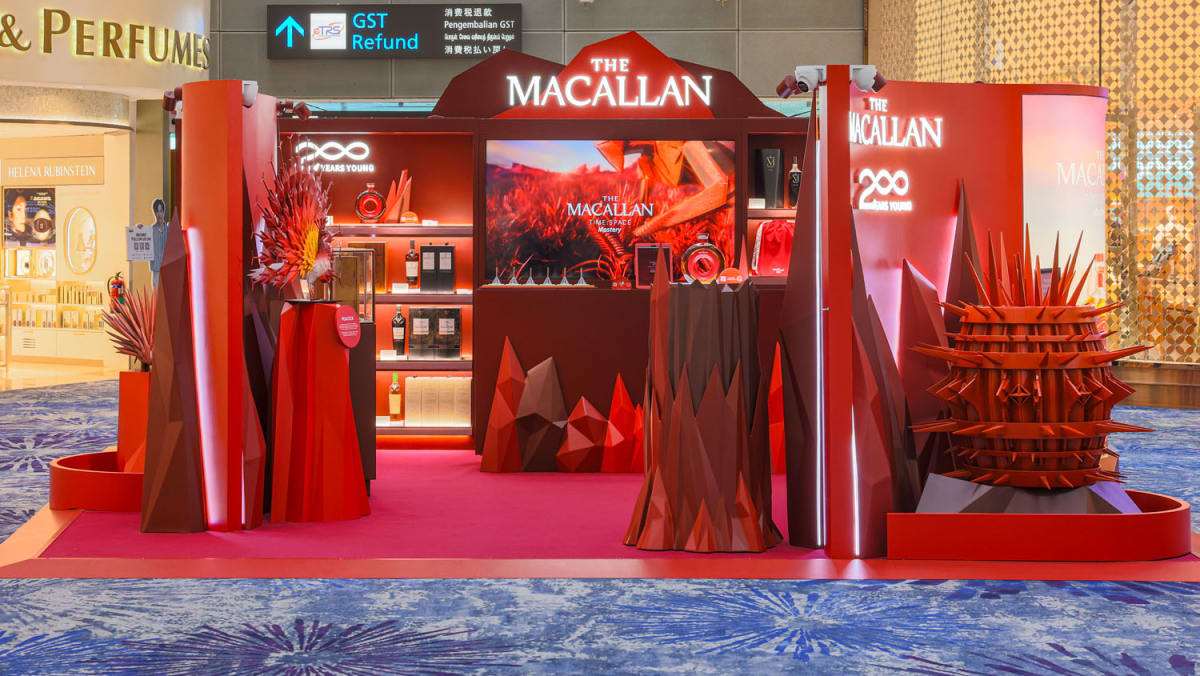When Dr Paul Chang Zhi Quan began collecting wine as a hobby during the pandemic, he did not expect that just four years later, it would lead him to amass nearly 500 bottles.
The 36-year-old general practitioner has handpicked every bottle in his collection, with half of it taking up three wine fridges at home and the rest in a storage locker that he rents.
“My parents didn’t have a wine collecting habit, but I’m building my own collection. During the pandemic, I couldn’t stop watching YouTube videos (about wine),” said Dr Chang.
What keeps the hobby alive is not just the bottles he savours, but also the community he has discovered along the way, made up of people who share his passion for the drink.
These days, he regularly meets with three wine-drinking groups, including one that he formed with other Instagram users after sharing his wine notes on the social media platform. The mentors he met during these sessions helped him further his knowledge in wine, he said.
“What my mentors told me is that wine is a double time capsule. For producers, it captures the vintage and what they did for the year. For us, it captures the time you open it and the company you share it with,” Dr Chang added.
 Dr Paul Chan has collected nearly 500 bottles of wine. (Photo: CNA/Nuria Ling)
Dr Paul Chan has collected nearly 500 bottles of wine. (Photo: CNA/Nuria Ling)
A year ago, Ms Jasmine Xu, a 34-year-old senior workplace analyst, found the conversations amid the wine drinking “intimidating” during wine-tasting events hosted by a sommelier friend.
“At that point in time, I struggled a little bit because I did not understand what people were talking about. To me, it was just grape juice, everything tasted the same,” said Ms Xu.
However, piqued by detailed discussions of the different methods of production and the wineries worldwide, Ms Xu's curiosity led her to take two internationally-recognised wine accreditation courses from the Wine and Spirit Education Trust (WSET).
Far from the stereotypes of stuffy, high-society aficionados, Singapore’s wine enthusiasts today are diverse, ranging from young professionals and seasoned collectors to casual hobbyists and even supermarket shoppers.
Speaking to wine collectors, sommeliers, and those in the trade, CNA TODAY found that wine sales have been on the rise, as people who are new to wine are starting their own bottle collections at home.
Part of the reason for this is because wine appreciation in Singapore is becoming increasingly accessible, not just to the well-heeled. More young people are also embracing wine as a drink of choice.
The Singapore Wine Club, for instance, has tapped into this rising interest, hosting 10 themed wine dinners since the club opened in May, all of which have sold out to groups of 10 to 20 diners.
These dinners include various masterclasses and themed food pairings, such as a recommended pairing of Sauvignon Blanc with fried Hokkien prawn noodle or Spanish Albariño with vadai and ikan bilis, in a bid to “demystify wine for Singaporeans”.
“There’s still unfortunately a pervasive mindset that wine is for (foreigners) or the ‘bougie’ crowd, and we’re all about dispelling that misconception,” said a club spokesperson.
“Part of the reason wine seems alien to so many Asians is that we always picture wine with European food. But we’ve had amazing pairings with Asian food, and especially hawker food.”
On the business side, new ventures are tapping into the growing consumer interest in wine, though this enthusiasm does not necessarily translate to smooth sailing for wine businesses.
Supermarkets have made it a point to expand their in store and online offerings, stocking anything from S$15 bottles to more premium bottles that run into the hundreds.
In what is surely a sign that the wine hobby has entered the heartlands, there are now wine bars in the aisles of neighbourhood supermarkets, where shoppers can try specially curated cocktails like "The Woodleigh Club", a sparkling wine cocktail offered in the bar at FairPrice Finest in Woodleigh Mall.
September saw the opening of the world’s first retail store of global wine rating app Vivino in Raffles City, featuring exclusive access to some of the top wines in the world as voted by Vivino's community.
Then, there is three-month-old VITIS, a wine bar and bistro in Duo Galleria, which describes itself as the first in the world to specialise in Asian wines, carrying over 100 wine brands from Japan, China, Thailand and India.
This new generation of wine upstarts mean stiff competition for existing importers and wine bar owners as they face rising costs, evolving consumer tastes, and a greater need to stand out from their competitors.
CNA TODAY takes a closer look at Singapore’s increasing affinity with wine culture, what has spurred this trend, and the vibrant community of retailers, importers and wine bars catering to local tastes.
 Wine selection at Black Cow, one of the restaurants that gets their wine from the wine platform VinGo Asia. (Photo: CNA/Nuria Ling)
Wine selection at Black Cow, one of the restaurants that gets their wine from the wine platform VinGo Asia. (Photo: CNA/Nuria Ling)
SINGAPORE'S LOVE AFFAIR WITH WINE
Once a niche often associated with exclusive groups of "wine snobs", wine lovers say that the culture has gradually shed that image over the years as the public's interest in wine grew.
Singapore's love affair with wine began decades ago. For instance, the International Wine and Food Society of Singapore has been meeting around six times a year since 1965, said its president Dr Martin Lim.
The society currently has around 100 members over the age of 50, and the group is actively trying to recruit younger members, he said.
The turning point was the COVID-19 pandemic, which began in early 2020. Pandemic lockdowns proved to be a boon for online wine businesses as people sought comfort in at-home dining experiences, wine apps and even virtual vineyard tours.
Pandemic drinking became a trend, as people resorted to various types of alcohol to cope with the stress and boredom alone at home in the absence of social outlets. As a result, more people also discovered and started to see wine in a different light.
Chartered accountant Gurmeet Sidhu, whose interest in wine started while he was studying in an Australian university in the 1980s, said that he has seen offerings in Singapore greatly expand.
“When I first returned to Singapore, there were hardly any wine boutiques and even the supermarkets did not carry any wine labels. There are pubs and restaurants that offer wine but they were costly and mainly new world wines from Australia,” said the 59-year-old.
In recent times, however, Mr Sidhu has noticed the proliferation of wine boutiques, supermarkets with dedicated wine cellars, online wine distributors, reflecting the “growing taste” of Singaporean consumers.
He cited retailers such as Wine Connection offering “better quality wines” from Europe and South America and retailing these bottles without a “huge markup” as one reason consumers' appetites have grown.
In response to CNA TODAY’s queries, a spokesperson for wine retailer 1855 The Bottle Shop said the chain’s online sales “picked up exponentially” during the early days of COVID-19, prompting the company to launch more flash sales to keep online shoppers engaged.
The brand’s loyalty programme, Club 1855, which offers members exclusive discounts, boasts over 10,000 members to date.
Mr Koh Chin Liang, managing director of another local retailer, Bottles & Bottles, which has 12 outlets islandwide, said that wine purchases are increasing, especially for “informal occasions”.
“The COVID-19 lockdowns encouraged consumers to switch their spend to wine at home and to trade up," said Mr Koh.
He added that with online platforms and delivery services growing in importance after the pandemic, prices are also becoming more transparent. This means online retailers have to “tread carefully” to balance gaining market share and managing logistics costs.
In any case, Mr Koh said that consumer positive attitudes towards wine did not dissipate after the pandemic.
"This change in behaviour appears to be sustained as restrictions relax and on-trade drinking returns,” he added.
 There's a growing interest among young people in wine collection. (Photo: CNA/ Nuria Ling)
There's a growing interest among young people in wine collection. (Photo: CNA/ Nuria Ling)
BRINGING WINE TO THE MASSES
While global interest in wine may be growing, the surge in local demand is likely driven by the population’s increasing affluence, said business and hospitality experts.
Dr Wang Peng, a business analytics lecturer at the Singapore University of Social Sciences (SUSS), said that wine sales here have consistently grown, with a 5.9 per cent compound annual growth rate from 2018 to 2022, reaching 15.5 million litres, according to one Canadian market intelligence report.
“A growing middle class with increased disposable income is more inclined to spend on premium and diverse wine options, driving market growth,” he said.
Many consumers turned to wine as an “affordable luxury” during the pandemic, with 45 per cent of Singaporeans reporting increased spending on alcoholic beverages, Dr Wang added.
Wine lovers said it used to be the case that people recognised only certain brands, vineyards or winemakers and tend to associate their positive reputation with quality, which is why many of these wines fetch high premiums.
But in recent years, the accessibility to wine information online has brought about a growing focus on "QPR", or quality-price ratio, which is a measure of how much quality a bottle of wine offers in relation to its price.
This is partially due to apps like Vivino, a wine-rating platform and marketplace, in democratising wine knowledge.
The app, which has 65 million downloads across the globe, allows users to scan wine labels and instantly access reviews, ratings, and average prices and explore wines based on their taste profile.
Users can also rate the wines that they have tasted, which adds to the overall rating for the wine. This sets Vivino apart from the pantheon of wine review platforms that rely on a small number of critics who typically review wines from premium winemakers.
Vivino's store spokesperson told CNA TODAY that its main focus of its first retail store at Raffles City is to replicate the experience of “walking into the app”. It also has a wine bar which offers some tapas and wines to drink by the bottle or the glass.
A person may not know much about wine, but the store allows them to pick up a decent bottle because they can easily see what is the Vivino rating for the bottles on sale in the store.
Supermarkets here have also up their ante, offering a wide variety of entry-level and premium labels.
A FairPrice Group spokesperson said that demand has grown for sparkling, white and rose wines, even as red wines from Australia, Chile and Bordeaux in France remain customer favourites.
FairPrice outlets also offer in-store tastings and masterclasses with product experts. Its membership scheme Just Wine Club, which offers an 8 per cent discount on wine, has seen over 20 per cent annual membership growth for the past five years.
A spokesperson for the DFI Retail Group, the parent company of brands such as Cold Storage and Giant, said there has been “significant growth” across the entire wine segment, with rising demand not only for premium brands but also for wines in the S$15 to S$20 range. Some premium options are also available in the range of S$100 to S$400 a bottle.
“During COVID-19, we saw a shift towards prioritising wine quality as customers looked to elevate their in-home experiences with finer wine. During this time, customers were looking for wines with a storied heritage and recognised branding,” said the spokesperson.
Cold Storage and CS Fresh outlets in “upscale areas” have seen a higher demand for premium wines and curated selections from boutique wineries, while stores in the heartlands report great interest in “affordably priced” wines, the spokesperson added.
One wine aficionado, Mr Tan Koon Yan, 36, said that while wine is still generally seen as a luxury good, these moves by supermarkets to stock more affordable wines makes the hobby more accessible to the mass consumer.
Said Mr Tan, who works in the shipping industry: "It's not that out of reach anymore. It's not something they see as something to drink only during festive seasons. Nowadays, you go to FairPrice or even Sheng Siong, the variety is so much and you don't know what to buy."
Besides expanding their in store and online offerings, supermarkets have also adopted a whole gamut of strategies to attract customers, spanning online subscription services, curated in-store wine bars and and wine fairs.
In 2022, the FairPrice Finest outlet at Centrepoint opened its doors with a new concept inside, the Grocer Bar, serving up wine, cheese platters and freshly-shucked oysters.
According to a catalogue of FairPrice Group stories published in 2023, in the months since the new concept opened in Centrepoint, the bar proved to be so popular that the number of seats expanded from just a few to over 40.
There are now four Grocer Bar locations across Singapore, including in the heartlands, at FairPrice Finest Century Square and FairPrice Finest Woodleigh Mall, and at a new bar at FairPrice Finest Clarke Quay which opened this year.
CNA TODAY reached out to the FairPrice Group and DFI Retail Group to inquire on customer response to such offerings so far.
 Wine sold at Cold Storage supermarket on Dec 12, 2024. (Photo: CNA/Nuria Ling)
Wine sold at Cold Storage supermarket on Dec 12, 2024. (Photo: CNA/Nuria Ling)
CASUAL DRINKER OR OENOPHILE?
So, what separates the casual drinker from the wine connoisseur, also known as an oenophile?
According to Associate Professor Lee Kuan-Huei, director of programmes in business, communication, and design at the Singapore Institute of Technology (SIT), appreciating wine requires education, much like understanding other “less familiar foods” such as cheese.
Enthusiasts range from amateurs who are attracted to wine but may have limited knowledge, to newcomers who are eager to learn more about wine and view it as a good opportunity for relationship building, said Assoc Prof Lee, who specialises in the hospitality industry.
At the other end of the spectrum are individuals with a deep understanding of wine, including its origins, production processes, and properties such as taste and aroma of different varieties.
But wine educators say the gap between amateurs and aficionados is closing, as more people access online resources or opt to advance their knowledge and understanding through wine appreciation courses, some of which are eligible for SkillsFuture subsidies.
Mr Sean Ou, co-founder and head of education at The Beverage Clique Academy, said that the profile of students attending its wine courses is now evenly split between industry professionals and consumers keen on deepening their personal knowledge on the subject.
Founded in 2016, The Beverage Clique Academy is an education provider that specialises in wine, spirits, beer and sake certification courses and has over 3,000 alumni to date.
“Recently, people want to know what they’re drinking, and make sure that they’re getting their money’s worth and putting good things in their body,” said Mr Ou.
He attributed this shift to the growing “maturity of the market“, with wine increasingly seen as a marker of lifestyle sophistication. For professionals, particularly in corporate settings, wine knowledge can enhance social engagements.
To the uninitiated, a passion for wine might evoke the image of a heavy drinker. But for true enthusiasts, it’s less about quantity and more about quality and understanding.
Ms Jaclene Liew, founder and CEO of wine platform VinGo Asia, which connects wine trade with wine consumers, said that younger drinkers in their late 20s and early 30s are becoming more discerning about what they drink.
Younger drinkers now prefer to "drink less but drink better", she said, likening this conscious approach to a broader trend among young people in choosing brands that reflect their values.
To make wine appreciation more approachable, Ms Liew creates wine-related content on social media, breaking down topics that might be complex to the layman, such as explaining the differences between wine from the Bordeaux and Burgundy regions in under one minute.
She also offers candid insights into the realities of running a wine business.
“I don’t think wine should have a high barrier to entry,” she explained. “At trade events, I need to be very technical, but for private customers, it’s never about how much sugar or acidity the wine has. Nobody cares about that — they care about the story (of the people) behind it.”
 Ms Jaclene Liew, 30, founder and CEO of wine platform VinGo Asia. (Photo: CNA/Nuria Ling)
Ms Jaclene Liew, 30, founder and CEO of wine platform VinGo Asia. (Photo: CNA/Nuria Ling)
For many, their first meaningful encounter with wine comes through learning the lingo for client-facing roles or through being inspired by the effort that goes into a bottle — experiences that have spurred some to turn their passion into business ventures.
Mr Wilson Goh, director of Lux Wine, stores around 15,000 bottles of wine in Singapore and France, including en primeur wines purchased while still aging in barrels. These exclusive vintages allow customers to invest before they are bottled.
As a wine investor, Mr Goh buys bottles expected to appreciate in value over time due to rarity, vintage quality, and market demand, later selling them for a profit.
“I’m a drinker myself, I love wines. I focus on French wines, Burgundies, because if you buy something you like and will drink, you’ll never fail. Worst case, I drink it myself,” he said.
In 2020, Mr Kevin Tan went from a casual collector to business owner by launching Allegro Fine Wines, specialising in award-winning Italian wines. His visits to family-run vineyards in Italy introduced him to unique appassimento method — a traditional winemaking technique involving partially drying grapes to concentrate flavors in an Italian red wine, Amarone.
“We choose wines that not only offer exceptional taste but also embody unique stories and traditions. There's a growing interest among consumers in sustainably produced wines and those with a strong familial or historical background,” said Mr Tan.
WHAT IS SINGAPORE UNCORKING?
While individual consumers vary in their preferences for reds and whites, there are some enduring and emerging trends on the wines that people here tend to pick up.
A spokesperson for 1855 The Bottle Shop said that red wine sales are generally “more dominant” than that of white wine.
Singaporeans still gravitate towards classic regions of the old and new worlds, in particular France, Australia, Italy, and Napa Valley in the United States, but consumers have grown more “inquisitive and eager” to explore regions and varietals beyond the established realms, such as South African wines, the spokesperson added.
Mr Koh Chin Liang, managing director of Bottles & Bottles Singapore, said Bordeaux, Burgundy and Italian wines are some of the more popular wine choices for the “seasoned drinkers”.
Australian and Californian wines – known as “new world” selections – tend to appeal to casual drinkers, Mr Koh said.
He said customers today are more informed and adventurous, thanks to wineries' branding efforts and the reach of social platforms. These have introduced consumers to a wider variety of wines, including Chablis, a renowned French region known for its Chardonnay, and Pinot Grigio, a popular grape varietal, both often seen as alternatives to more established choices like New Zealand Sauvignon Blanc.
A Vivino spokesperson also noted that favoured regions like Bordeaux continue to reign supreme but highlighted “interesting upticks” in Argentinian reds and whites, Portuguese reds and a small but upward trend of demand for Chinese wines.
Over at VITIS Wine Bar and Bistro, which specialises in wines with an Asian connection, founder Gary Low said the “standout favourites” are the Silver Heights Marselan from Ningxia in China, Domaine Yui A3 Pinot Noir from Hokkaido in Japan, and Weightstone White No. 4 from Taiwan’s only wine domaine, Houli Valley.
Co-founders at RVLT wine bar, Mr Ian Lim and Mr Alvin Gho, focus on wines made from grapes farmed with organic and sustainable practices and enjoy “championing the underdogs”.
This includes wine from Georgia, a former Soviet republic that has over 8,000 years of history in winemaking, and amber wine made by Papari Valley in Georgia, which is fermented according to traditional customs in a clay vessel, said Mr Lim.
As for what’s next for Singapore’s wine culture, he said wines made with more “authentic approaches” and wines from lesser known regions and lesser known grapes, are likely to see more interest with Singaporeans now more open to discover wines and embrace different styles.
Collapse Expand
NOT ALL ROSY FOR WINE BARS AND IMPORTERS
Driven by increasingly sophisticated consumers eager to explore global wine options, the Singapore market is becoming a growing focus for importers, retailers and sommeliers as a regional wine hub.
Despite the absence of domestic vineyards here, experts said Singapore's thriving import market has boosted the city-state's status and allowed local F&B businesses access to a wide range of bottles across the world.
Experts say the ease of trade here makes Singapore on par with leading wine consumer-centric industries like Hong Kong and New York, where one can easily find relatively uncommon bottles from Georgia and the Middle East region.
“Previously, the wine scene in Singapore was broadly divided into just two camps: You had achingly hip natural wine bars complete with the neon lighting, industrial design and colorful Instagram feeds, and the more old-school white tablecloth places with stiff-upper-lip sommeliers and bank-breaking Burgundy lists,” said the Singapore Wine Club spokesperson.
Now, however, the scene is bustling with outlets ranging from friendly neighbourhood wine bars to exclusive members’ clubs like 67 Pall Mall, to ultra-niche wine bars and the more intimate, social wine clubs open to those at any stage of their wine journey.
Despite the buzz in the scene, wine retailers are not immune to the longstanding challenges faced by the wider F&B industry.
Describing these challenges, Mr Gary Low, founder and managing director of VITIS Wine Bar and Bistro said the growing competition is what drives margins “to the ground”.
“The major challenge with wine bars and restaurants in these cities is that everyone’s selling exactly the same wines. From the supermarket to local cafes, from the small restaurants to the Michelin rated ones, everyone’s carrying and selling almost the same selection as one another,” said Mr Low.
So he has opted to tap into an “unsatiated demand” for wines with an Asian connection in Singapore’s “curious but not fanatical” consumer base.
However, even wine bars with unique offerings, such as RVLT Wine Bar, which has championed sustainable farming in vineyards and embraced the craft of wine instead of focusing on brand names, recently announced that it would not be extending its lease when it expires next year.
Co-founded by Mr Ian Lim and Mr Alvin Gho in 2017 with a goal to make wine drinking more fun and accessible for aspiring wine drinkers, Mr Lim said that it is no longer sustainable with costs surging and a drop in customers post-pandemic.
“The first two years post-Covid were great. 2023 to 2024 has been trying, business has dropped 30 to 45 per cent month on month,” said Mr Lim.
“The biggest challenge would be economies of scale, or lack thereof, simply because we are independent and solo. We are not able to compete with the big players when it comes to pricing up or pricing down,” said Mr Gho.
Mr Lim added that the “hypercompetitive” Singapore wine industry has made Singapore lush with a countless selection of wines, though this makes it difficult for small businesses “doing it for passion”.
“Many wine suppliers are constantly introducing new wines into the market just because it’s popular or trendy. When the trend fades out, they clear it out and move on with no emotions,” said Mr Lim.
Likewise, local wine importers face stiff competition in a saturated market.
“Our initial challenge was getting customers to buy our wines because there are already a number of popular retailers in the market as well as in e-commerce and their wine prices are quite attractive,” said a spokesperson from Wine and Farm, which has been importing premium European wines since 2020.
Assoc Prof Lee from SIT agreed that it is tough for smaller brands and newcomers to penetrate the industry.
“The wine market in Singapore faces many challenges, such as limited space and high rental cost, limited local production as most wines are imported from overseas, high tax rates and competition,” said Assoc Prof Lee.
While some market valuations have placed Singapore’s wine market at an estimated S$690 million in 2024, its relatively small population limits the potential for “exponential growth,” she added.
Attracting manpower to the food and beverage industry is also crucial in helping the local wine industry to flourish.
Mr Gerald Lu, president of the Sommelier Association of Singapore, is no stranger to the challenges of attracting Singaporeans to the F&B trade – of the group’s 250 members, only 30 per cent are Singaporeans or permanent residents.
At Praelum Wine Bistro, where Mr Lu is founder and owner, he ensures that all his staff are recognised as sommeliers, paving pathways for their career progression, with its website even listing where former sommeliers have gone on to work after being mentored there.
“A vision is that one day we will win the world’s best sommelier title. We can be leaders in terms of sommeliers and hospitality in Asia and show the world, why not? We have a strong culinary history, top cocktail bars; it’s just that we’re small and in Asia,” said Mr Lu.
Such aspirations, combined with a more informed consumer base eager to delve into the nuances of wine, offer hope that wine appreciation will become increasingly inclusive here.
 Mr Gerald Lu, owner of wine bar Praelum and president of the Sommelier Association of Singapore. (Photo: CNA/Nuria Ling)
Mr Gerald Lu, owner of wine bar Praelum and president of the Sommelier Association of Singapore. (Photo: CNA/Nuria Ling)
When Ms Shamini Krishnan began her career in the wine industry over a decade ago as a 21-year-old sommelier, a customer once told her to call her superior, since he doubted her ability to offer guidance on wine at a fine dining establishment.
On another occasion eight years ago, a winemaker from Burgundy, France, told her that she was “just an Asian” while claiming that wine was “in his blood”.
Nowadays, such holier-than-thou attitudes are out of date, given the expanding interest in wine among consumers and producers worldwide.
Reflecting on her experiences, Ms Shamini, now 36 and the head sommelier at a Singapore-based South African wine company Wine to Share, said: “Back then, people wanted to see an older gentleman in a suit who spoke like a walking wine encyclopedia. That was the notion of wine expertise. But it’s very intimidating, isn’t it?”
“For me, I don’t want to intimidate anyone. I believe wine should be welcoming. Five years ago, if someone saw an Asian winemaker, they’d laugh and dismiss it. But the country and palate is changing. Now, an Asian winemaker or wine bar can be truly inspiring,” she added.



.jpg?itok=HVcXoYme)










































